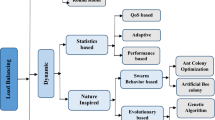Abstract
Graphical workflow modeling tools, such as UML and DAG, can facilitate users to express workflow process logic, but lack of abilities to carry out simulation and correctness checking. In this paper, based on Petri net, we propose a service composition oriented Grid workflow model and its related six elementary workflow patterns: sequence, condition, iteration, concurrency, synchronization, and triggering. In addition, we present our Grid workflow analysis approaches on three aspects: workflow reachability verification, workflow deadlock verification, and workflow optimization. The experimental results show that our workflow verification and optimization mechanisms are feasible and efficient.
Similar content being viewed by others
References
Foster I, Kesselman C, Tuecke S (2001) The anatomy of the Grid: enabling scalable virtual organizations. Int J High Perform Comput Appl 15:200–222
Foster I, Kishimoto H, Savva A, Berry D et al. (2005) The open Grid services architecture, version 1.50. Available: http://forge.Gridforum.org/projects/ogsa-wg
Grønmo R, Solheim I (2004) Towards modeling web service composition in UML. In: Proceedings of 2nd international workshop on Web services: modeling, architecture and infrastructure, Porto, Portugal
Hall R, Rosenberg AL, Venkataramani A (2007) A comparison of DAG-scheduling strategies for Internet-based computing. In: Proc 22nd international parallel and distributed processing symposium (IPDPS)
Jin H (2004) ChinaGrid: making Grid computing a reality. In: Proceedings of international conference of Asian digital libraries, Shanghai, China. Lecture notes in computer science, vol 3334. Springer, Berlin, pp 13–24
Andrews T, Curbera F, Dholakia H, Goland Y, Klein J, Leymann F, Liu K, Roller D, Smith D, Thatte S, Trickovic I, Weerawarana S (2003) Business process execution language for web services version 1.1. BEA Systems, IBM Corporation, Microsoft Corporation, SAP AG, Siebel Systems
Jüngel M, Kindler E, Weber M (2000) The Petri net markup language. Algorithmen und Werkzeuge für Petrinetze (AWPN). Koblenz
Petri CA (1962) Kommunikation mit Automaten. PhD thesis, Institut für instrumentelle Mathematik, Bonn
van der Aalst WMP (1998) The application of Petri nets to workflow management. J Circuits Syst Comput 8:21–66
van der Aalst WMP (1997) Verification of workflow nets. In: Application and theory of Petri nets. Lecture notes in computer science, vol 1248. Springer, Berlin, pp 407–426
Ezpeleta J, Colom JM, Martinez J (1995) A Petri net based deadlock prevention policy for flexible manufacturing systems. IEEE Trans Robot Autom 11:173–184
Murata T (1989) Petri nets: properties, analysis and applications. In: Proceedings of the IEEE, vol 77, pp 541–580
van der Aalst WMP, ter Hofstede AHM, Kiepuszewski B, Barros AP (2002) Workflow patterns. QUT technical report, FIT-TR-2002-02, Queensland University of Technology, Brisbane
Geeraerts G (2007) Coverability and expressiveness properties of well-structured transition systems. PhD thesis, Universit’e Libre de Bruxelles, Belgium
Finkel A, Geeraerts G, Raskin JF, Van Begin L (2005) A counter-example the the minimal coverability tree algorithm. Technical report 535, Universit’e Libre de Bruxelles
Stahl C (2005) A Petri net semantics for BPEL. Technical report, Humboldt-Universität zu Berlin
Ouyang C, Verbeek E, van der Aalst WMP, Breutel S, Dumas M, ter Hofstede AHM (2005) Formal semantics and analysis of control flow in WS-BPEL. Technical report (revised version), Queensland University of Technology
Mantell K (2010) From UML to BPEL: model driven architecture in a web services world. IBM. Available: http://www-128.ibm.com/developerworks/webservices/library/ws-uml2bpel/
Thain D, Tannenbaum T, Livny M (2004) Distributed computing in practice: the Condor experience. Concurr Comput 17:2–4
Ouyang C, Verbeek E, van der Aalst WMP, Breutel S, Dumas M, ter Hofstede AHM (2005) WofBPEL: a tool for automated analysis of BPEL processes. In: Proceedings of the 3rd international conference on service–oriented computing. Lecture notes in computer science, vol 3826. Springer, Berlin, pp 484–489
Sadiq W, Orlowska ME (2000) Analyzing process models using graph reduction techniques. Inf Syst (Oxf) 25(2):117–134
ImageMagick (2010) Available: http://www.imagemagick.org/
Author information
Authors and Affiliations
Corresponding authors
Rights and permissions
About this article
Cite this article
Cao, H., Jin, H., Wu, S. et al. Petri net based Grid workflow verification and optimization. J Supercomput 66, 1215–1230 (2013). https://doi.org/10.1007/s11227-011-0668-3
Published:
Issue Date:
DOI: https://doi.org/10.1007/s11227-011-0668-3




